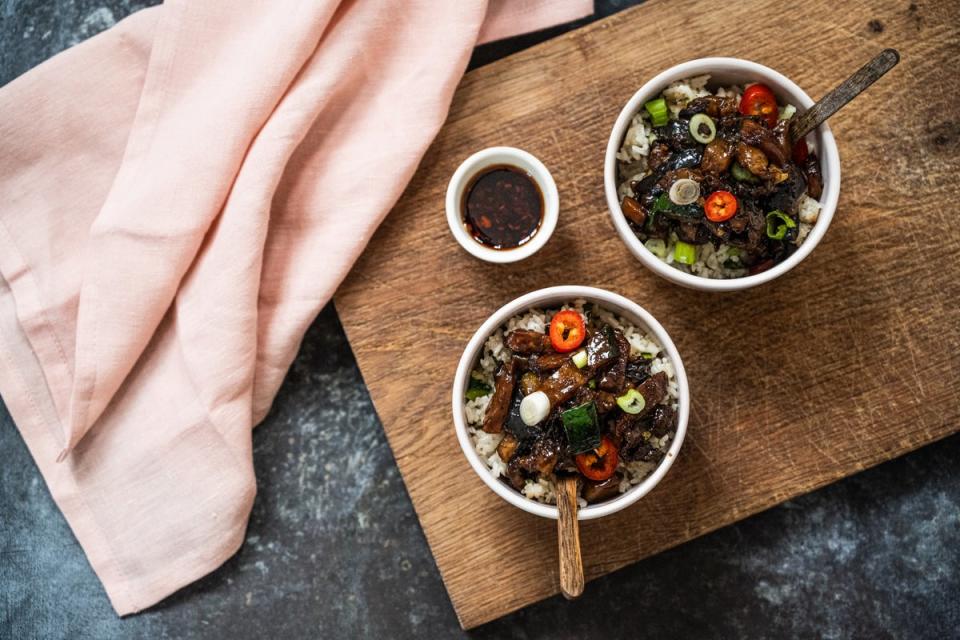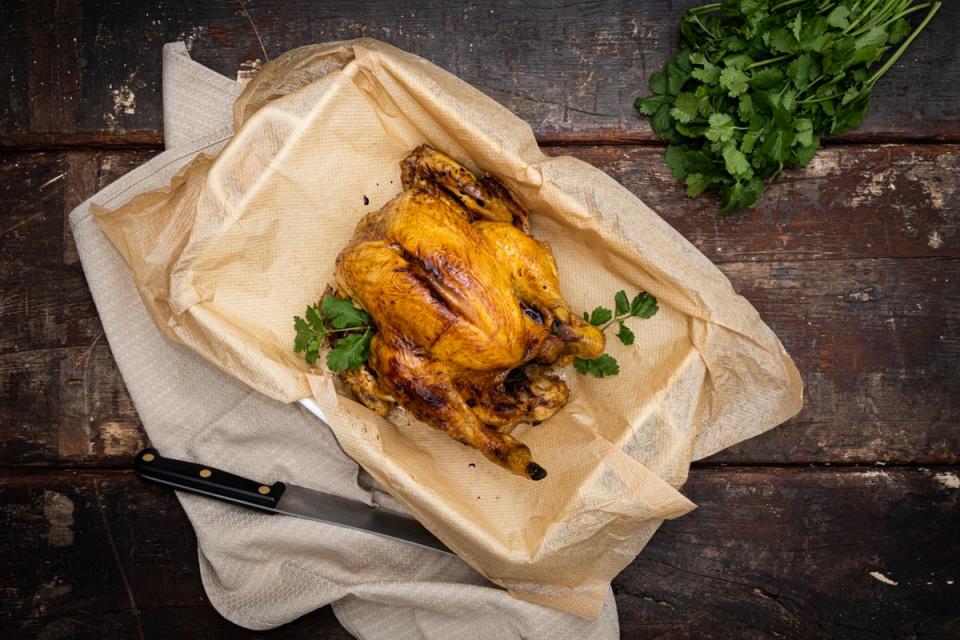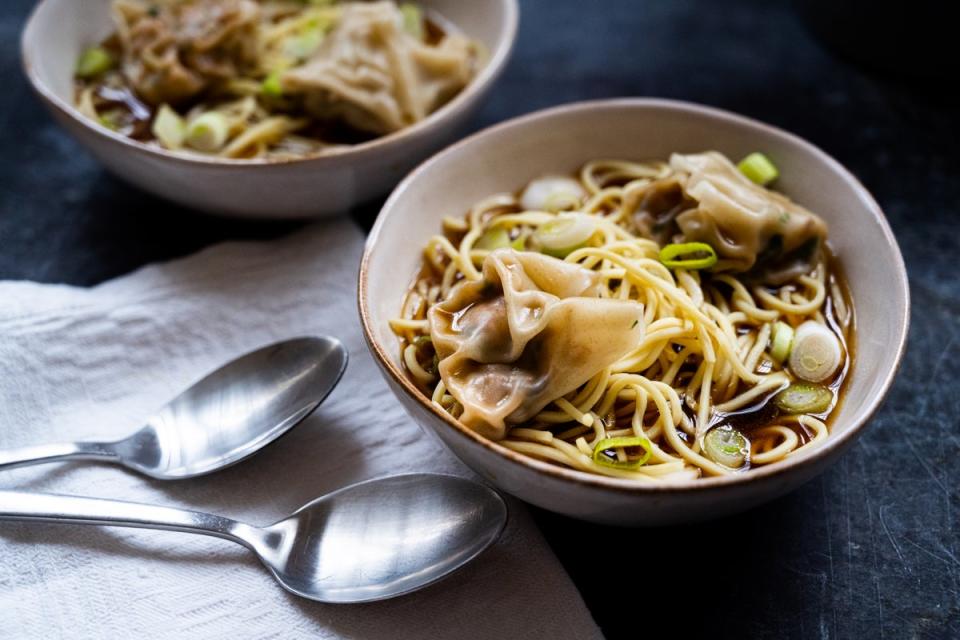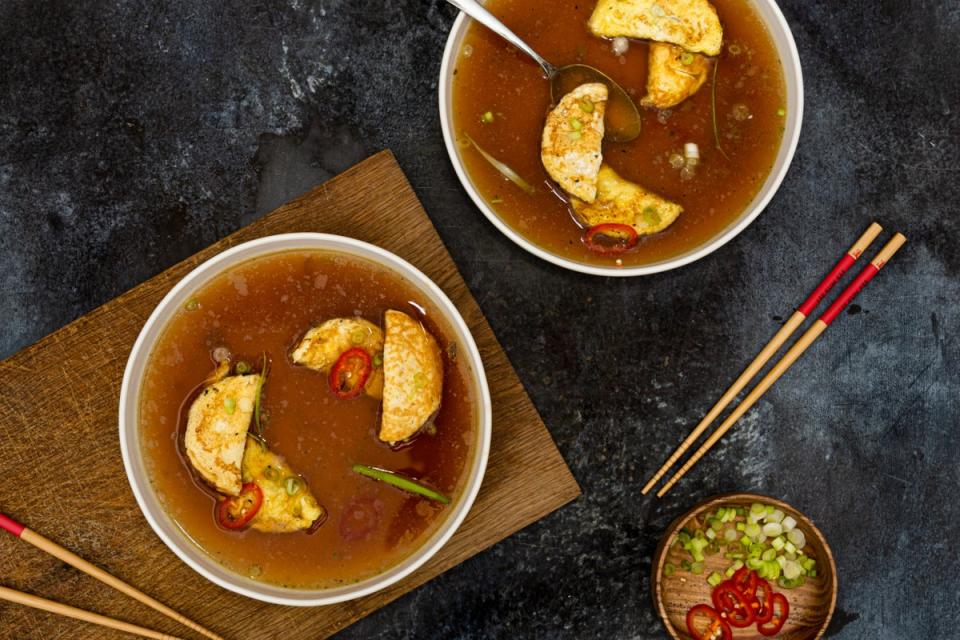Celebrate the Year of the Dragon with a culinary journey through China
Food plays a vital role in Chinese New Year celebrations, with most dishes symbolising luck, prosperity and new beginnings.
With the Year of the Dragon just around the corner, make sure there’s something for everyone at your dinner table with these recipes from celebrity chef Jeremy Pang and scientist-turned-cook Philippa Middlehurst, AKA Pippy Eats.
In collaboration with Chinese sauce brand Lee Kum Kee, the recipes take you on a journey across the eight regional cuisines of China, from Zhejiang (fit for an emperor) to Cantonese (popular at local food stalls), all from the comfort of your own kitchen.
Four-joy veggie meatballs (Shangdong cuisine)
The original recipe for four-joy meatballs is one of the oldest in the world, with meatballs symbolising luck, fortune, prosperity and happiness.
This vegan version is best served with Lee Kum Kee’s Oriental Sesame Soy Sauce – a blend of light soy sauce, aged vinegar, garlic, chilli and sesame oil, making a rich savoury, aromatic, tangy dressing paired perfectly with rice. It’s a true testament to Shandong cuisine – the first in China – which represents the traditions of ancient northern China and was an essential part of imperial banquets.
Ingredients:
For the veggie balls:
460g five-spice tofu
100g water chestnuts (1 tin), finely diced
1 pack tenderstem broccoli
2 spring onions
6 tbsp panko breadcrumbs
1 tbsp Lee Kum Kee Premium Light Soy Sauce
1 tbsp Lee Kum Kee Char Siu Sauce
1 tbsp Lee Kum Kee Sesame Wok Oil
1 tsp grated ginger
1 tsp cornflour
Sauce mix:
2 tbsp light brown sugar
2 tbsp Lee Kum Kee Premium Light Soy Sauce
1 tbsp Lee Kum Kee Mushroom Vegetarian Stir-Fry sauce
1 tbsp water
200ml water
1 tbsp grated ginger
Slurry:
1 tbsp water
1 tsp cornflour
Method:
1. Add the tofu, ginger, spring onion, Light Soy Sauce and Char Siu Sauce to a blender and whizz up to form a thick paste. Add to a mixing bowl and fold through the finely diced water chestnuts. Add the panko breadcrumbs and cornflour. Stir well to combine.
2. With wet hands, form the mixture into eight large balls and set on a greaseproof lined sheet. Place in the fridge for at least an hour to firm up.
3. Oven bake on a greaseproof lined baking tray at 200C for 30 minutes, turning frequently.
4. Steam the broccoli for five minutes until al dente but still green. Strain in a colander and set aside.
5. In a non-stick frying pan, heat a tablespoon of Sesame Wok Oil. Add the ginger and fry for 30 seconds until fragrant. Add sauce mix and stir well to combine. Add 200ml water and bring to a steady simmer.
6. Mix the cornflour with a tablespoon of water and stir to dissolve. Add the slurry to the sauce until thicken.
7. Add the meatballs to the sauce and gently turn until the meatballs are just warmed through.
8. Plate broccoli around a serving plate and place meatballs in the middle, then serve with Oriental Sesame Soy Sauce.
Vegan Fujian fried rice (Fujian cuisine)

This special rice dish is cooked with Lee Kum Kee’s Mushroom Vegetarian Stir Fry Sauce, a veggie alternative to its oyster sauce, achieving a similar texture and appearance. Its gravy-like texture works well in Fujian cuisine, which often features soups and dishes rich in sauces, with simmering and stewing being the the most celebrated cooking methods.
Ingredients:
250g pre-cooked rice or ready-to-use microwave rice from pouch
3 dried shiitake mushrooms
2 spring onions, julienned
1 courgette, diced into cubes
1 long aubergine, or regular aubergine, cut into 2cm x 1cm rounds
½ celeriac, cut into ½cm by 2cm strips
1 tbsp Lee Kum Kee Sesame Wok Oil
1 tsp grated ginger
1 clove garlic, grated
Sauce mix:
2 tbsp Lee Kum Kee Mushroom Vegetarian Stir-Fry Sauce
1 tbsp Lee Kum Kee Premium Light Soy Sauce
1 tsp light brown sugar
120ml water
Garnish:
Served with dollop of Lee Kum Kee Chiu Chow Chilli Oil
1 spring onion, finely sliced
Method:
1. Cross hatch the top and bottom of aubergine rounds, to resemble scallops. Cut the celeriac to resemble squid. Slice the rehydrated shiitake mushrooms. Dice the courgette.
2. Heat the sesame wok oil in a heavy based frying pan over a medium high, heat and fry the garlic and ginger for one minute until fragrant.
3. Add the aubergine rounds and fry the cross hatched top for 1-2 minutes until golden, then turn and fry the other side. Remove and set aside.
4. Add the celeriac and fry until golden. Remove and set aside.
5. Add sauce mix and bring to a gentle simmer. Put the aubergine and celeriac back into the sauce and toss to coat. Add the courgette and cook for a further minute. Set aside.
6. In a separate non-stick frying pan, heat two tablespoons sesame wok oil over a medium high heat. Add the rice and break apart any clumps. Add the sliced shiitake and courgette and keep moving the rice for 2-3 minutes until the courgette is cooked through. Season with a pinch of salt.
7. Top the rice with the braised aubergine and celeriac sauce. Top with finely sliced spring onion and a dollop of chiu chow chilli oil.
Mala beef (Sichuan cuisine)

Sichuan is notoriously humid in the winter and hot in the summer. To counteract soggy weather, the Sichuanese historically spiked their diet with warming foods like ginger and Sichuan pepper. This dish features Lee Kum Kee’s Sichuan Style Hot and Spicy Stir-fry Sauce, which is described as “everything in Sichuan in a jar”, with its distinct aroma and taste that creates a subtle mouth-numbing experience. The end result is a rich beef bound to be the centre of any celebratory spread.
Ingredients:
180g flank steak/skirt steak, sliced into strips
½ carrot, julienned
½ white onion, thinly sliced
2 spring onions, julienned
2 cloves garlic, sliced
Thumb-size piece of ginger, julienned
1 tsp Lee Kum Kee Sesame Wok Oil
1 tsp freshly ground Sichuan peppercorn
Sauce mix:
2 tbsp water
2 tbsp Lee Kum Kee Sichuan Style Hot and Spicy Stir-Fry Sauce
1 tbsp Lee Kum Kee Hot Chilli Soy Sauce
1 tbsp Lee Kum Kee Pure Sesame Oil
2 tsp light brown sugar
Garnish:
2 tsp toasted sesame seeds
Substitute: No steak? Vegetarian? Try soya chunks instead.
Method:
1. Heat a wok over a high heat and add Sesame Wok Oil. Add beef strips and brown for 2-3 minutes. Remove the beef and set aside.
2. Add the ginger and garlic to the wok and fry for one minute. Add sauce mix. Add the white onion and carrot. Cook for 1-2 minutes.
3. Add the beef back into the sauce and add the spring onions. Add sesame wok oil and ground Sichuan peppercorn. Cook for a further 30 seconds then remove from the heat and serve. Garnish with toasted sesame seeds.
Sweet and sour “squirrel squid” (Jiangsu cuisine)

Jiangsu cuisine boasts strictly selected ingredients, exquisite workmanship, and rich culture, with fresh seafood being one of the main features.
The Lee Kum Kee Seasoned Rice Vinegar – made from authentic Zhenjiang vinegar (Zhenjiang being a city in Jiangsu Province) – creates a slightly sour flavour paired with a blend of sweet, tangy and smoky notes. This dish references one of the famous dishes in Jiangsu cuisine – squirrel Mandarin fish – but comes now with a twist.
Ingredients:
250g prepared whole squid
2 spring onions, julienned
½ red onion, sliced
½ yellow pepper, julienned
½ red pepper, julienned
1 clove garlic
2 tbsp cornflour
1 tbsp vegetable oil
Pinch salt
Sauce mix:
4 tbsp Lee Kum Kee Seasoned Rice Vinegar
4 tbsp chicken stock (or water)
2 tbsp Lee Kum Kee Premium Light Soy Sauce
2 tbsp Lee Kum Kee Chilli Garlic Sauce
2 tbsp light brown sugar
1 tbsp ketchup
1 tsp cornflour
Substitute: No squid? Vegetarian? Try oyster mushroom instead.
Method:
1. Prepare the squid by scoring in a 1cm cross hatch – be sure not to go all the way through. Once cut, cut each fillet into six pieces.
2. Combine sauce mix in a jug. Set aside.
3. Add cornflour and salt in a shallow bowl. Add the squid pieces and gently toss to coat.
4. Fill a heavy based frying pan/pot with around 2cm deep of vegetable oil and heat to 180C.
5. Shallow fry the squid in the hot oil. Once become golden brown (after a minute or so), turn each piece to fry the other side. The squid pieces should curl up slightly. Drain on kitchen paper and set aside.
6. Heat one tablespoon vegetable oil in a heavy based frying pan. Add the sliced garlic and fry for 30 seconds until fragrant. Add the vegetable to stir fry for two minutes then add in the sauce mix and simmer until reduced.
7. Add the crispy squid to the sauce, toss gently to coat then serve immediately.
Looking for a way to please your Chinese New Year guests at the dinner table? Well, look no further because with the help of Hong Kong-based sauce brand Lee Kum Kee, celebrity chef Jeremy Pang has four more recipes from four distinct Chinese cuisine traditions that will surely delight your taste buds.
Emperor lotus roasted chicken (Zhejiang cuisine)

Zhejiang Cuisine is celebrated for featuring “southern ingredients cooked the northern way”, using culinary skills brought from the north across The Beijing-Hangzhou Grand Canal. This special chicken dish – served to the region’s Emperor by the local people and eventually added to his imperial menu – uses the clay-wrapped method of slow cooking, which dates back thousands of years. Here, it is marinated with Lee Kum Kee’s Premium Light Soy Sauce for a distinct rich flavour and Premium Dark Soy Sauce for a hint of sweetness.
Serves: 4-6
Ingredients:
1 whole free-range corn-fed chicken
2 lotus leaves, soaked in hot water for 1 hour (alternative: baking/greaseproof parchment paper)
Whole spices:
10 bay leaves
6 star anise
2 large cinnamon sticks
2 handfuls dragonwell tea, steeped in hot water for 3 minutes
For the dough:
600g plain flour
350-400ml water
Marinade:
4 tbsp Lee Kum Kee Premium Light Soy Sauce
4 tbsp Lee Kum Kee Premium Dark Soy Sauce
2 tbsp Lee Kum Kee Yellow Bean Sauce
2 tbsp sugar
50ml rice wine
Method:
1. Cut any hard, pointy ends off the soaked lotus leaves so that they don’t poke through the dough.
2. Mix the marinade.
3. Place whole spices into the chicken cavity. Massage marinade all over the cavities of the chickens. Place in a large seal food bag, pour excess marinade into the cavity of the chicken, seal and refrigerate overnight or marinate for at least an hour.
4. Mix dough ingredients and knead well for five minutes until smooth.
5. Roll the dough out roughly 3-4mm thick, ensuring there is enough dough to wrap around the whole chicken.
6. Lay two lotus leaves on top of the rolled-out dough. Place the chicken in the middle of the leaves.
7. Wrap the leaves and then the dough tightly around the chicken, not to pierce the dough. Use a little water to seal the dough.
8. Place the whole wrapped chicken onto a flour dusted roasting tray into a preheated oven at 200C for 2-2.5 hours.
9. Cut around the centre of the cooked dough and remove the lid of dough to reveal the chicken.
Hunan spicy fish (Hunan cuisine)

For many years, the local Hunan people have adapted to eating hot and spicy food to help eliminate moisture from the body, built up from living in this notoriously humid region. This spicy fish dish is drenched in a luxurious sauce made with Lee Kum Kee’s spicy Chilli Bean Sauce – a complex blend of salted chilli peppers, soybean and broad beans pastes.
Serves: 2
Ingredients:
350g white fish fillet (cod/haddock)
1 tbsp Lee Kum Kee Premium Light Soy Sauce
1 tbsp vegetable oil
½ thumb-sized piece ginger, finely chopped
2 cloves garlic, finely chopped
3 spring onions, finely chopped
Topping:
1 tbsp Lee Kum Kee Sesame Wok Oil
4 large red chillies, finely chopped
2 ready-roasted red peppers, fine chopped
Sauce mix:
2 tsp Lee Kum Kee Chilli Bean Sauce
½ tbsp Lee Kum Kee Double Deluxe Soy Sauce
¼ tsp sugar
Substitute: No fish? Vegetarian? Try tofu instead
Method:
1. Heat 1 tablespoon Sesame Wok Oil with a medium-low heat wok and add the red chillies and roasted red pepper, and fry for 8-10 minutes, stir well until softened. Pour sauce mix into the wok in the last minute of cooking.
2. Pour topping onto a large heatproof plate that fits into a large steamer or steam basket. Place the fish fillet on top and put the plate into the steamer.
3. Place the steamer or steam basket onto wok filled halfway up with hot water. Bring to a vigorous boil and steam for 8-10 minutes (depends on the thickness of the fish).
4. Remove the fish from the steam.
5. Heat one tablespoon vegetable oil to a smoking point and pour over the top of the ginger, garlic, and spring onions. Spread the oil over the fish and pour the Light Soy Sauce over the top.
Wonton braised noodles with tobiko and salmon roe (Cantonese cuisine)

Oyster Sauce – a longtime all-purpose staple in Chinese cooking – brings out the umami in any ingredient it touches, whether it’s used for marinating, stewing or just dipping. Lee Kum Kee’s Premium Oyster Sauce, used in this dish, is a balanced blend of chillies, garlic and spices prepared from an authentic recipe from Chiu Chow in China, and works perfectly in Cantonese cooking, as well as Western dishes. The word “wonton” also translates to “clouds” in Cantonese, similar to what the wontons look like floating in the broth!
Serves: 2
Ingredients:
200g fresh wonton noodles
25 pcs fresh wonton pastries
Topping (optional):
2 tsp tobiko/salmon roe
For the stock:
400ml chicken stock
1 tbsp Lee Kum Kee Premium Oyster Sauce
½ tbsp Lee Kum Kee Premium Light Soy Sauce
For the filling:
300g raw prawns, peeled and de-veined (finely chop half and roughly chopped the rest in bigger chunks)
1 spring onion, finely chopped
½ thumb sized piece of ginger, finely chopped
Small handful coriander
Handful fresh shiitake mushrooms, finely chopped
For the marinade:
1 tsp Lee Kum Kee Premium Oyster Sauce
½ tsp Lee Kum Kee Pure Sesame Oil
¼ tsp salt
1 tsp sugar
½ tbsp cornflour
For the garnish:
Spring onion, finely sliced in ring
For the dipping sauce (optional):
2 tbsp Lee Kum Kee Chiu Chow Chilli Oil
Substitute: No wontons? Vegetarian? Use veggie dumplings (Chinese chives, shiitake mushrooms, carrots) instead.
Method:
1. Place spring onion, ginger, and mushrooms in a mixing bowl.
2. Mix marinade with filling.
3. Boil stock on a medium heat for 15 minutes.
4. Fill a saucepan ¾ full of hot water and bring to boil. Once boiling, add noodles and blanch for 1½ minutes and fish them with tongs and drain.
5. Boil the wontons (usually 5-6 wontons per serving) in the same water for 3-4 minutes on a medium heat. Remove the wontons and then bring the water or soup back to the boil.
6. Before serving, dunk the noodles into the stock for 30 seconds, then serve in a bowl.
7. Place the hot wontons on top of the noodles, spoon one ladle of stock over the noodles and wontons.
8. Scatter two teaspoons of tobiko or salmon roe over the wontons and add garnish.
Tips to fold the wonton:
1. Place the pastry diagonal to you and add one teaspoon filling into the centre.
2. Dip your fingertip lightly into a bowl of water and run the tip around the edges of the pastry.
3. Overlap the edges to form a triangle and then pick the pasty up and gather the sides together to form a fan-like, money bag shape.
4. Repeat until all the pastry or filling has been used.
Braised egg dumplings in chilli broth (vegetarian) (Anhui cuisine)

Anhui cuisine is known for featuring local ingredients (especially wild herbs), with braising – the cooking method used for this dish – used as one of the most common techniques. These dumplings, using egg instead of traditional dumpling skins, dip perfectly in Lee Kum Kee’s Sweet Soy Sauce, which is specially brewed from premium soybeans and has a treacly texture that leaves a rich complex flavour on the palate.
Serves: 2
Ingredients:
4 eggs
2 pak choi stems, cut lengthways in quarters
3 tsp cornflour paste (2 tsp cornflour and 2 tsp water mixed well)
½ tsp Lee Kum Kee Pure Sesame Oil
¼ tsp salt
For th filling:
200g chives, finely chopped
100g watercress, finely chopped
100g leek, finely chopped
100g firm fresh tofu, finely chopped
1 clove garlic, finely chopped
1 spring onion, finely chopped
1 tsp Lee Kum Kee Pure Sesame Oil
½ tsp sugar
¼ tsp salt
¼ tsp pinch black pepper
For the broth:
300ml vegetable stock
1½ tbsp Lee Kum Kee Sweet Soy Sauce
1 tbsp Lee Kum Kee Mushroom Vegetarian Stir-Fry Sauce
Method:
1. Beat the eggs and season with ¼ teaspoon salt and ½ teaspoon sesame oil.
2. Mix filling well.
3. Mix broth ingredients well.
4. Heat one tablespoon vegetable oil in a frying pan to a medium heat. To make one “dumpling”, pour 1-2 tablespoon beaten egg into the pan and try to keep in one spot with a spatula to create a mini omelette.
5. Turn to low heat so that the egg doesn’t cook too quickly. Spoon one teaspoon of filling into the centre of the egg and then fold it over and press the sides of the semicircle down so that the egg seals around the filling. Repeat this until all the egg or all the filling has been used.
6. Once each egg dumpling has been sealed, remove from the pan immediately and set aside.
7. Heat one tablespoon vegetable oil in a saucepan on a medium heat.
8. Pour the broth ingredients into the pan and bring to boil. Once boiling, add three teaspoons of the cornflour paste into the sauce and stir well whilst boiling for a minute or so.
9. Place the egg dumplings into the broth and boil for 4-5 minutes and serve.


